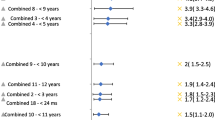Abstract
To study prevalence rates of pervasive developmental disorder (PDD) symptoms and differences between subtypes in school age Iranian children. A random sample of 2,000 school age children from both genders was selected. A parent-completed, DSM-IV-referenced rating scale of PDD symptoms was used. About 1.9% of the sample obtained screening cutoff scores for probable autistic disorder and 0.5 for probable asperger’s disorder. The rate of probable PDD was not more in girls than the boys. The rate of suspected cases of PDD in Iran is very high and probable autistic disorder is not gender related. It shows the need for more consideration of PDD in the mental health programs planning.

Similar content being viewed by others
References
Alfven, G. (1993). The covariation of common psychosomatic symptoms among children from socio-economically differing residential areas. An epidemiological study. Acta Paediatrics, 82, 484–487.
Alipour, A., & Esmaile, E. M. (2004). Studying of validity, reliability, and cutoff points of CSI-4 in the school children aged 6 to 4 in Tehran. Exceptional students’ Research Center (Farsi Book).
American Psychiatric Association. (1994). Diagnostic and statistical manual of mental disorders, fourth edition. Washington DC: American Psychiatric Association.
Baird, G., Simonoff, E., Pickles, A., Chandler, S., Loucas, T., Meldrum, D., & Charman, T. (2006). Prevalence of disorders of the autism spectrum in a population cohort of children in South Thames: The Special Needs and Autism Project (SNAP). Lancet, 15, 210–215.
Blaxill, M. F. (2004). What’s going on? The question of time trends in autism. Public Health Reports, 19, 536–551.
Chakrabarti, S., & Fombonne, E. (2001). Pervasive developmental disorders in preschool children. Journal of American Medical Association, 285(24), 3093–3099.
Fombonne, E., Zakarian, R., Bennett, A., Meng, L., & McLean-Heywood, D. (2006). Pervasive developmental disorders in Montreal, Quebec, Canada: Prevalence and links with immunizations. Pediatrics, 118, e139–150.
Gadow, K. D., & Sprafkin, J. (1998). Child symptom inventory-4 screening manual. Stony Brook, NY: Checkmate Plus.
Gadow, K. D., & Sprafkin, J. (1999). 1999 revised norms and scoring guide child symptom inventory-4. Stony Brook, NY: Checkmate Plus.
Gillberg, C. (1998). Asperger syndrome and high-functioning autism. British Journal of Psychiatry, 172, 200–209.
Grether, J. K. (2006). Epidemiology of autism: Current controversies and research directions. Clinical Neuroscience Research, 6, 119–126.
Gurney, J. G., Fritz, M. S., Ness, K. K., Sievers, P., Newschaffer, C. J., & Shapiro, E. G. (2003). Analysis of prevalence trends of autism spectrum disorder in Minnesota. Archives of Pediatrics and Adolescent Medicine, 157, 622–627.
Haq, I., & Couteur, A. (2004). Autism spectrum disorder. Medicine, 32, 61–63.
Holtmann, M., Bölte, S., & Poustka, F. (2007). Autism spectrum disorders: Sex differences in autistic behaviour domains and coexisting psychopathology. Developmental Medicine and Child Neurology, 49, 361–366.
Icasiano, F., Hewson, P., Machet, P., Cooper, C., & Marshall, A. (2004). Childhood autism spectrum disorder in the Barwon region: A community based study. Journal of Paediatrics and Child Health, 40, 696–701.
Newschaffer, C. J., Falb, M. D., & Gurney, J. G. (2005). National autism prevalence trends from United States special education data. Pediatrics, 115, e277–282.
Petersen, D. J., Bilenberg, N., Hoerder, K., & Gillberg, C. (2006). The population prevalence of child psychiatric disorders in Danish 8- to 9-year-old children. European Child & Adolescent Psychiatry, 15, 71–78.
Wazana, A., Bresnahan, M., & Kline, J. (2007). The autism epidemic: Fact or artifact? Journal of the American Academy of Child and Adolescent Psychiatry, 46, 721–730.
Acknowledgments
The author thanks Ms. Mehrfard for her help in gathering of the data and Ms. Lori Klein for editing of the manuscript.
Author information
Authors and Affiliations
Corresponding author
Rights and permissions
About this article
Cite this article
Ghanizadeh, A. A Preliminary Study on Screening Prevalence of Pervasive Developmental Disorder in Schoolchildren in Iran. J Autism Dev Disord 38, 759–763 (2008). https://doi.org/10.1007/s10803-007-0445-6
Received:
Accepted:
Published:
Issue Date:
DOI: https://doi.org/10.1007/s10803-007-0445-6




